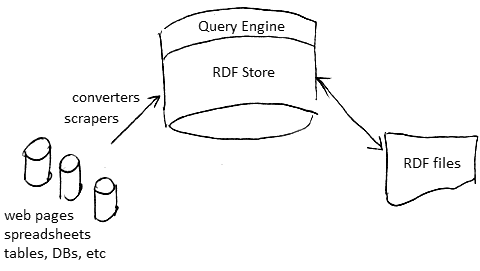Difference between revisions of "Semantic Web Application Architecture"
(→Sources) |
|||
| Line 47: | Line 47: | ||
== Sources == | == Sources == | ||
* [[Semantic Web for the Working Ontologist (book)]] | * [[Semantic Web for the Working Ontologist (book)]] | ||
| − | * Web Data Management | + | * [[Web Data Management (book)]] |
[[Category:Semantic Web]] | [[Category:Semantic Web]] | ||
Latest revision as of 15:40, 23 November 2015
Contents
Semantic Web Application Architecture
How to use Semantic Web in your application?
Main tools:
- RDF parsers, serializers and converters
- RDF Store (sometimes called Triple Store)
- RDF Query Engine
Parsers & Serializers
Parser
Serializer
- does the opposite: from a graph it creates a serialized version of it
RDF Converters
Sometimes the data source is not in RDF form
- e.g. relational databases, spreadsheets
- but also can be microformats - special attributes in HTML tags (business cards or events)
- or RDFa - same idea, embed RDF into HTML attributes
- to have machine-processable HTML data
RDF Store
This is a database
- tuned for storing and retrieving triples
- also should have an ability to merge information from multiple data sources (unlike Relational Databases)
RDF Query Engine
Closely related to #RDF Store
- SPARQL: runs structured queries on the store to retrieve data
- SPARQL is not only a query language, but also a protocol
- so a query engine can be a web service

Libraries
- Sesame [1] - RDF Store and QE
- SimpleNLG [2] - translates RDF statements into English
- NLG - Natural Language Generation